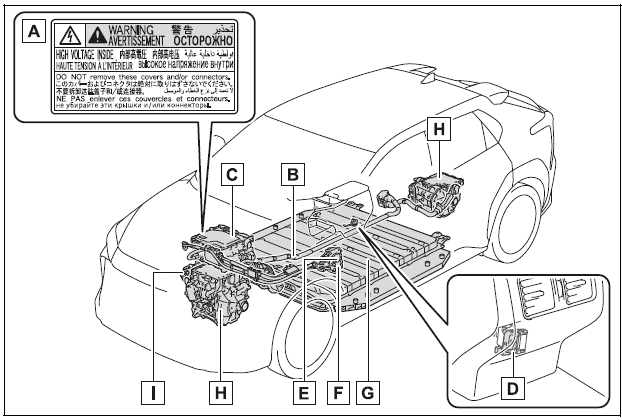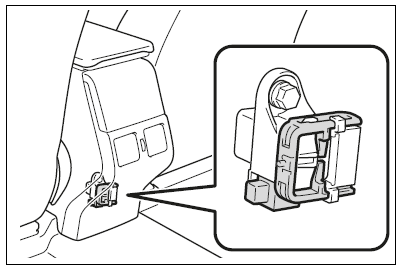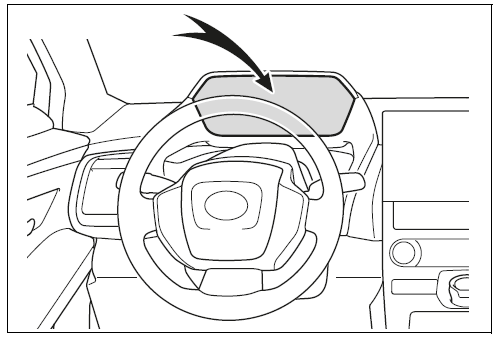Toyota bZ4X Owner's Manual: Electric Vehicle System Precautions
Battery electric vehicles incorporate high-voltage components, including the traction battery (nominal voltage: 355.2 V), electricity supply unit, orange-colored high-voltage cables, and electric motor. Additionally, high-temperature elements like the cooling radiator require careful handling to avoid safety risks.
Key Safety Considerations:
- High-voltage components feature warning labels-read them carefully before handling.
- Direct contact with high-voltage cables or connectors can result in severe electric shock-avoid touching these parts.
- Only trained technicians should conduct repairs involving electrical systems to prevent accidents.
- After operating the EV system, some areas may become hot-use caution when inspecting the vehicle.
- In the event of an accident, never approach exposed electrical wiring or leaking fluids from the traction battery.
Understanding Electromagnetic Waves
High-voltage systems in electric vehicles are equipped with electromagnetic shielding, emitting levels of electromagnetic waves comparable to conventional gasoline-powered vehicles or household electronics. However, some third-party radio accessories may experience interference.
How the Traction Battery Works
The lithium-ion traction battery enables efficient energy storage but naturally degrades over time. Factors such as temperature, charging habits, and driving conditions influence battery longevity. While capacity reduction affects driving range, overall performance remains stable. Proper battery care minimizes deterioration.
Cold Weather Impact on the EV System
Extreme cold temperatures (below -30°C) can prevent the EV system from starting. If the battery freezes, wait for ambient temperatures to rise before attempting ignition.
Road Safety Measures in Case of an Accident
- Move the vehicle to a safe location and engage the parking brake.
- Do not touch high-voltage components, especially exposed cables.
- If liquid leakage occurs, avoid contact-electrolytes can cause skin irritation or serious injury.
- Stay away from the vehicle if smoke or vapors are emitted from the battery.
- If a fire occurs, evacuate immediately and use an extinguisher designed for electrical fires.
Safety remains a priority when handling electric vehicle components. Understanding how high-voltage systems function reduces risks while ensuring a smooth and efficient driving experience.
System components

The illustration is an example for explanation and may differ from the actual
item.
- Warning label
- High voltage cables (orange)
- ESU: Electricity Supply Unit (built in onboard traction battery
charger/DC-DC converter)
- Service plug
- AC charging inlet
- DC charging inlet
- Traction battery
- Electric motor (traction motor)/Inverter (front/rear*)
- Air conditioning compressor
*: AWD models only
Electromagnetic Waves and Electric Vehicles
Battery electric vehicles utilize high-voltage components, which are equipped with electromagnetic shielding. This ensures that the level of electromagnetic waves emitted remains similar to that of conventional gasoline-powered vehicles and common household electronics.
Potential Interference with Radio Equipment
- Although electromagnetic shielding minimizes interference, some third-party radio accessories may experience signal distortion when used near the vehicle.
- Drivers may notice minor disruptions in radio signals or electronic devices that rely on precise frequencies.
Traction Battery (Lithium-Ion Battery) Lifespan and Maintenance
The traction battery is the primary energy storage unit in battery electric vehicles, but it has a limited service life. Over time, its capacity to hold a charge decreases, similar to other rechargeable batteries. This reduction is influenced by several factors:
- Environmental conditions such as temperature extremes can accelerate battery degradation.
- Frequent rapid charging or deep discharging cycles may affect long-term battery health.
- Driving habits, including excessive acceleration or prolonged high-speed driving, can impact battery efficiency.
Impact of Battery Wear on Vehicle Performance
As battery capacity gradually decreases, the vehicle's driving range is reduced. However, overall performance, including acceleration and handling, remains stable. This decline is a normal characteristic of lithium-ion technology and does not indicate a malfunction.
Best Practices for Extending Battery Life
- Avoid exposing the battery to extreme hot or cold temperatures for prolonged periods.
- Use moderate charging cycles rather than frequent rapid charging to maintain battery longevity.
- Optimize driving habits by reducing unnecessary acceleration and maintaining steady speeds.
By following these precautions, drivers can extend the lifespan of their vehicle’s traction battery while ensuring consistent performance and efficiency over time.
Starting the EV System in an Extremely Cold Environment
Battery electric vehicles rely on optimal battery temperatures for efficient operation. When the traction battery is exposed to extreme cold (below approximately -22°F [-30°C]), the EV system may temporarily become unresponsive. Cold conditions affect the battery's chemical processes, reducing its ability to deliver power.
Steps to Start the EV System in Cold Weather:
- Allow the vehicle to remain in a warmer environment if possible, such as a garage or insulated space.
- Wait for the outside temperature to rise naturally or for sunlight to help warm the battery.
- Avoid multiple restart attempts if the system does not activate immediately-this prevents excessive battery strain.
- Use scheduled pre-conditioning features if available, helping gradually warm the battery before driving.
Additional Considerations:
- Extreme cold affects battery efficiency, leading to temporary reductions in driving range until temperatures stabilize.
- Parking in sheltered locations during winter reduces battery exposure to freezing temperatures.
- Consistent charging habits help maintain battery health, preventing deep discharges that exacerbate cold-weather performance issues.
Managing battery temperatures effectively ensures reliable EV operation in harsh conditions, allowing for smoother winter driving experiences.
WARNING
High-Voltage Precautions
Battery electric vehicles operate using high-voltage DC and AC systems alongside a standard 12-volt system. While these advanced electrical systems enhance vehicle performance, improper handling of high-voltage components can pose serious risks.
Safety Risks and Precautions:
- Never touch, disassemble, remove, or replace high-voltage components, cables (identified by their orange color), or connectors.
- The EV system generates high temperatures during operation. Always be cautious around electrical systems and follow the warning labels attached to various components.
- Never attempt to open the service plug access hole located under the floor. The service plug is designed exclusively for professional servicing and carries high-voltage electricity.
Additional Safety Recommendations:
- Only qualified technicians should handle high-voltage repairs and maintenance.
- After an accident, avoid contact with any exposed electrical wiring or damaged components to prevent shock hazards.
- If liquid leakage occurs from the traction battery, move away from the vehicle and seek professional assistance.
Understanding high-voltage precautions ensures safer handling of electric vehicles while minimizing risks during operation or maintenance.

Road Accident Cautions
Observe the following precautions to reduce the risk of death or serious injury:
- Stop the vehicle in a safe place to prevent secondary accidents.
- While pressing the brake pedal, apply the parking brake and shift the position to P to stop the EV system.
- Slowly release the brake pedal once the vehicle has been secured.
- Do not touch high-voltage parts, orange cables, or connectors.
- If electric wires are exposed inside or outside the vehicle, there is a risk of electric shock-never touch exposed wires.
- If liquid is leaking from the traction battery, avoid contact.
- Organic carbonate-based electrolyte can cause blindness or skin wounds.
- If it touches your eyes or skin, wash it off immediately with a large amount of water and seek medical attention.
- If electrolyte is leaking, do not approach the vehicle.
- Although battery design limits large leaks, electrolyte vapors may be emitted.
- These vapors are harmful to skin and eyes and could cause acute poisoning if inhaled.
- Avoid bringing high-temperature items or flames near electrolyte, as it may ignite and cause a fire.
- If a fire occurs, evacuate immediately.
- Never use a fire extinguisher that is not designed for electrical fires.
- Using even a small amount of water may be hazardous.
- If the vehicle needs to be towed, transport it with the front wheels (2WD models) or all four wheels (AWD models) raised.
- If the wheels connected to the traction motor touch the ground, electricity generated by the motor's movement could lead to a fire, depending on the damage.
- Check the ground under the vehicle for leaked fluids (other than water from the air conditioning).
- If a leak is detected, the traction battery may be damaged-move away from the vehicle and contact a dealer.
- Even minor accidents can impact the battery; schedule an inspection after any collision.
Following these safety precautions ensures a controlled response in emergency situations, helping to prevent injuries and damage.
Traction Battery
- Your vehicle contains a sealed lithium-ion battery.
- Never resell, hand over, or modify the traction battery. To prevent accidents, traction batteries removed from a disposed vehicle are collected through your Toyota dealer. Do not dispose of the battery yourself. Improper disposal can result in serious injury or environmental hazards.
- Do not illegally dispose of or dump the traction battery. Improper handling can lead to environmental harm or pose a risk of electric shock if high-voltage components are exposed.
- The traction battery is specifically designed for use with your electric vehicle. If modified or repurposed outside of the vehicle, hazards such as electric shock, excessive heat, smoke generation, explosions, and electrolyte leakage may occur.
- When reselling or transferring ownership, ensure the recipient is fully aware of battery safety precautions to prevent accidents.
- If the vehicle is disposed of without removing the traction battery, high-voltage parts, cables, and connectors may pose a risk of severe electric shock. The traction battery should always be removed by a Toyota dealer or qualified service shop.
- For details on traction battery collection, recycling, and disposal, contact your Toyota dealer to ensure safe handling.
Proper disposal and handling of the traction battery are essential to safety and environmental responsibility. Following manufacturer guidelines ensures reduced risks and effective recycling.
WARNING
Caution While Driving
Electric vehicles operate silently compared to traditional gasoline-powered cars, making them less noticeable to pedestrians, cyclists, and nearby vehicles. Since they lack engine noise, people may not realize the vehicle is moving or approaching. To ensure safety, always remain vigilant, especially in busy urban areas or pedestrian-heavy zones.
- Even with the Acoustic Vehicle Alerting System active, be extra cautious, as external conditions may diminish its effectiveness.
- Exercise patience when driving near crosswalks and public areas where pedestrians may not hear the vehicle approaching.
Impact-Related Risks
- If the vehicle’s underfloor receives a significant shock or impact, immediately stop in a safe location and inspect for potential damage.
- Check for leaks or visible cracks underneath the vehicle-traction battery damage can lead to serious hazards.
- If liquid leakage is detected, do not touch or approach the vehicle. Battery electrolyte can emit harmful vapors that may cause irritation or poisoning.
- Regardless of visible signs of damage, always have the traction battery inspected by a dealer if the vehicle has experienced an impact.
Modification Risks
Avoid modifications that lower the vehicle’s ride height. The traction battery is positioned beneath the vehicle, and reducing ground clearance increases the risk of battery contact with rough surfaces or debris.
- Lowering suspension or altering body structure may cause unintended stress on battery components.
- Damage to the traction battery can lead to overheating, electrolyte leakage, or, in extreme cases, fire hazards.
- If ride height adjustments are necessary, consult an expert to ensure compatibility with the vehicle's structural integrity.
Optimizing EV Performance and Safety
To maintain efficiency, adopt cautious driving habits that enhance battery longevity. Consistent charging practices, regulated speed management, and controlled acceleration contribute to optimal vehicle performance.
- Plan driving routes to minimize frequent stops and aggressive accelerations, conserving battery power.
- Preconditioning features can help regulate battery temperature, ensuring reliable performance in varying weather conditions.
- Regular inspections of key vehicle components, including high-voltage cables, prevent unexpected malfunctions.
By understanding key safety measures and adopting responsible driving habits, electric vehicles remain a highly efficient and safe alternative to conventional transportation.
Emergency shut off system
When a certain level of impact is
detected by the impact sensors,
the emergency shut off system
turns off the EV system and
blocks the high voltage current.
If the emergency shut off system
activates, your vehicle will not
restart. To restart the EV system,
contact your Toyota dealer.
Warning message
A message is automatically displayed
when a malfunction
occurs in the EV system or an
improper operation is attempted.

If a warning message is shown
on the multi-information display,
read the message and follow the
instructions.
If a warning light comes on, a
warning message is displayed,
or the 12-volt battery is disconnected
The EV system may not start.
In that case, try to start the system
again. If the "READY" indicator does
not come on, contact your Toyota
dealer.
When the Traction Battery Is Completely Discharged
If the EV system cannot be started due to the traction battery being fully discharged, it must be recharged before the vehicle can resume operation. Charging options include both AC charging (standard home or public chargers) and DC fast charging, which provides quicker replenishment of battery power.
Steps for Restarting After Battery Depletion:
- Connect the vehicle to an AC or DC charging station and initiate the charging process.
- Allow the battery to charge sufficiently until the traction battery charge warning light turns off.
- A fully depleted battery requires additional charging time, so it is advisable to plan charging sessions accordingly.
- Once the battery has gained sufficient charge, restart the EV system to verify operational readiness.
Best Practices for Avoiding Battery Drain:
- Monitor battery levels regularly and recharge before reaching critically low levels.
- Avoid deep discharges, as maintaining moderate charge levels improves long-term battery health.
- Utilize charging infrastructure strategically, ensuring access to stations before battery levels become critical.
- Consider regenerative braking to maximize energy recovery and reduce reliance on frequent external charging.
A well-managed charging routine ensures uninterrupted driving and maximizes battery lifespan, keeping electric vehicles efficient and reliable.
Battery electric vehicles (BEVs) operate differently from conventional gasoline-powered cars, relying on stored electricity rather than fuel combustion. This fundamental shift in powertrain technolo ...
Battery electric vehicles operate differently from conventional gasoline-powered cars. Their electricity consumption efficiency varies based on driving conditions, affecting range and overall perfor ...
Other articles:
Snow Mode for Enhanced Traction on Slippery Surfaces
Snow mode is a selectable driving mode in your 2025 Toyota bZ4X that is specifically designed to optimize vehicle performance and control when driving on slippery road surfaces, such as those covered in snow or ice.
Activating and Deactivating Snow Mode
To engage Snow mode in your vehicle, locate ...
Safe Exit Assist Operation – Detailed Conditions and Detection Limitations
The safe exit assist is operational when
The safe exit assist function is activated only when every one of the following conditions is met:
The power switch is ON, and either less than 3 minutes have elapsed since the EV system was turned off or since a door was opened and an occup ...



 Electric Vehicle system features
Electric Vehicle system features Battery Electric Vehicle Driving Tips
Battery Electric Vehicle Driving Tips